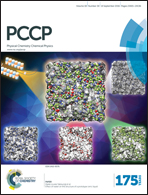Acceleration of convective dissolution by chemical reaction in a Hele–Shaw cell†
Abstract
New laboratory experiments quantify the destabilising effect of a second-order chemical reaction on the fingering instability of a diffusive boundary layer in a Hele–Shaw cell. We show that, for a given chemical system, the dynamics of such a reactive boundary layer is fully determined by two dimensionless groups, Da/Ra2, which measures the timescale for convection compared to those for reaction and diffusion, and CBo′, which reflects the excess of the environmental reactant species relative to the diffusing solute. Results of a systematic study varying CBo′ in the range 0–0.1 are presented. It is shown that the chemical reaction increases the growth rate of a perturbation and favours small wavelengths compared to the inert system. A higher concentration of CBo′ not only accelerates the onset of convection, but crucially also increases the transport of the solute by up to 150% compared to the inert system. This increase in solute transfer has important practical implications, such as in the storage of carbon dioxide in saline aquifers.


 Please wait while we load your content...
Please wait while we load your content...